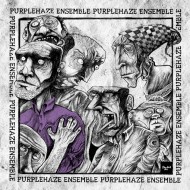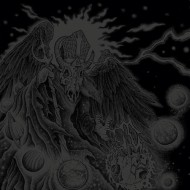
With the original concept of this documentary (not to be confused with the other As The Palaces Burn releases) confined to turning the cameras away from the band’s own music and their performances, Lamb Of God‘s intentions were to highlight the power of music and its influence on both the individuals and their fans – a refreshing series of viewpoints that might well have worked. Of course the arrests that followed, when they flew in to play a show in the Czech Republic on 28 June 2012, combined with the implicit level of trust that they had built up with the director, Don Argott, meant that the band took a collaborative decision to split the focus of the film’s direction.
Thus, the play opens with LOG frontman Randall D. Blythe, the self-confessed “dirtbag down by the river” (naturally, with “LOSER” emphatically emblazoned across his leather jacket) wandering along the James River in his hometown of Richmond, Virginia and musing over how his access to music has moulded him. “Music is my life. It’s what stopped me going to prison” — the irony of this statement soon comes to pass but, until that point we are invited into Lamb Of God’s practice room at the start of their album cycle. Here, whilst Randy does press, the rest of the band reflect on the rise of the band and their general disbelief at how their star just keeps on getting bigger. Here, with them all displaying natural, down-to-Earth qualities, there is a chance to emphasize the family men but also, interestingly, the individuals’ general disconnectedness, the fist-fights and Randy’s battle with alcohol abuse.
In between a few obligatory star spots for Slash, GWAR’s Oderus Ungerus and Slipknot’s Corey Taylor, we get a couple of moving fan stories on their connection to the music. Through Oscar (from Colombia) and Pratika (from India) we learn of their diverse backgrounds and the individual cultural anomalies they have, their loves and losses and, ultimately, their own relationship with music. You’d certainly expect more individual stories to be included, but there is just a general emphasis on the war-torn nature of some of the places that the band play and the united front that their fans display.

And then as the word “Prague” pops up on screen to replace others that have gone before it, everything changes. In an instant, the viewer must decide whether to take all consequent reportage at face-value and whether to consider the potential for the band to have used the situation to their commercial advantage, but considering the gravity of what follows, this would seem unlikely. The exploratory ramble that has gone before ends and the furious search for truth and justice begins right here, in our own minds as well as in those of the band members. We’re shown the inside of a plane and a queue of folks jostling to get off. Guitarist Mark Morton comments that, on seeing the menagerie of officials assembled on the ground, he perceived that, “there must be some fugitive on this plane.” How right he was. Of course, we all know that what follows is the band members’ arrests and a fierce line of initial questioning (guitarist Willy Adler angrily mentions that “they called [Randy] a fucking murderer”). “We waited to see what they were gonna do with Randy,” continues Mark, “and then they kept him.”
The intensity of the voices, the dark looks, the sudden silences, the manager’s heated phone conversation and the sudden appearance of a deathly serious legal team all indicate in exactly what position the band have been placed and the director pitches the tone perfectly. It slowly emerges that a fan, Daniel Nosek, present at an old Czech Lamb Of God gig, died soon after seeing them play and the implication is that Randy Blythe is being blamed for causing it. We subsequently see three contentious incidents, taken from footage filmed at the gig, that show a fan getting (or trying to get) on stage and attempts by security (and possibly Randy) to stop him. These blurry snippets of information are all there to give us a sense of the confusing circumstances and the possible validity and severity of the accusations.
When words like “murder” and phrases like “intent to cause harm” are being banded about, it isn’t so much a case of whether your eyes will be glued to the screen — it’s a case of whether you’ll ever be able to view this fucked-up world the same again. With the initial legal arguments being over bail (or the illusion of), the actual tragedy of the whole situation begins to dawn on the band. They are forced to come to terms with heartbreak and disbelief; the tragedy of losing a fan as well as having a colleague trapped in a cell in a foreign country. As Mark suggests later, “It was never us against them.” It’s an experience that Randy refers to later as like wearing a “lead helmet.”

The jump in the film here to the day of Randy’s release, 38 days later, might just represent the degree of misinformation that was reported, or simply, editorial discretion. The accompanying Q&A with Randy reveals a little about his time behind bars. The contact blackout he experienced, his fear of being singled out for punishment and getting through it by employing a daily routine of meditation, reading and writing – finding order where there was disorder. Just the imagery of the band and families waiting at the airport is enough to jolt a tear from the hardiest of souls. Willy, of course, says it all when he breaks down whilst hugging his friend — “I missed the fuck out of you… best day ever.”
With the court case hanging over them, their “comeback show” in an Iowa cornfield feels a little stilted but Randy’s delight at the faith the fans have shown in him is honest. When questioned later about the situation and whether he considered never returning for the trial, he is adamant that he couldn’t possibly do anything else. Knowing his own psychological vulnerabilities and his constant battle to stay sober, he suggests that not being able to look himself in the mirror would have resulted in an irresistible return to the bottle and inevitable self-implosion — “in my heart, it was just the right thing to do.”
Three months later and the preparation for the trial ramps up the pressure upon him and, by proxy, us viewers. Knowing he may have to explain why the fans want to launch themselves from a stage or the vagaries of slam-dancing shows just how little faith his legal team have in what the judges will know and understand. “Whatever happens, they can’t make me guilty” — it’s a sentence that pinpoints his state of mind. Then, the first day of the trial is upon us and Randy emerges sporting a haircut, fully booted and suited. Facing three judges (with one presiding) and just one prosecutor, there is immediately the sense that all is not well. Unsurprisingly, considering the event was nigh on 3 years ago, the subtitled witness statements prove to be sketchy at best. Immediately, Randy’s legal team are scrutinizing the reliability of the witnesses. There follows suggestion that Randy’s on-stage gestures were mistranslated as an invitation to “come up on stage,” and his criticism of security that night is duly reported.
What follows is the revelation that another fan’s home videos and photos from the night prove that the on-stage fan we see is not Daniel Nosek. That information would leave the judge with nothing in the way of video evidence to take into consideration, witness confusion and inconsistencies, and a clearly determined defense team having ticked all the boxes. Daniel’s uncle’s statement duly rams home the reality by admitting that Randy may not fully be to blame, but breaks hearts when he goes on to explain Daniel’s complex family situation and the mother’s severe mental anguish meaning she can no longer earn a living. No side will ever actually win this case. There will only be losers.

The final day of the trial rolls around and Randy still feels he will be found guilty on a lesser charge — possibly negligence which he suggests could get him 6 years in prison. In his final statement, a dejected and sombre Randy explains his emotions but says he is remaining objective; he is just desperate to reveal the truth. Upon hearing he has been “cleared of the charge of manslaughter” (his legal team are seen assuring him he has been “completely exonerated”) he remains stony-faced — just a shaky thumbs up that he understands is the only sign that he has understood. Predictably, we get a smack of dramatic music fading in as the judge’s verdict is fading out — without that, the moment would still be transferred to us through that single shot of Randy’s face, bursting with conflicting emotions. Back home, there are no band member celebrations — just reserved smiles and Willy’s statement, a few weeks later, that “It’s becoming a reality that we’re Lamb Of God again.” The final say goes, appropriately, to drummer Chris Adler’s insightful reflection: “Now we’ve been through this really traumatic event together, I would dare to say, until one of us dies, we’re stuck together.”
Such is the disparate nature of the original concept and the end result, it is easy to draw the conclusion that one cannot breathe next to the other. There is certainly a sense of that when you compare the diverse reactions drawn from the varied characters’ ponderous connection to the music, with the united intensity of the band’s own powerful emotions that surround the trial. There are moments of gravity in both concepts but, no matter where your starting point, one will impact more on you and on an extremely personal level, the other far less so. No flippant directorial attempt to loop us back to that original idea (which does come near the film’s end) was ever going to make this release about anything but an insatiable thirst for some insight behind this whole strange and sorry saga. On that front, this documentary comes through in spades. Its story is clear as a bell, beautifully composed and, despite the initial doubts at the potential damage that filming such a hot potato might have and the subtle hints towards showing the best side of the band, their integrity remains intact.
One thing that is made clear during the bonus material, is that we certainly won’t be seeing Lamb Of God back in the Czech Republic unless the family of Daniel Nosek specifically request it — unexpectedly, those associations and implications kicked off by this case being brought into being will last forever. Essentially, this documentary is Lamb Of God’s way of passing their “lead helmet” on to us. Watching and absorbing the events of the trial are a grave, upsetting and deeply profound experience and, on a personal level, it feels like an honour to be given such unique access to an event that has and will continue to change lives.
Also online @ Heavy Blog Is Heavy = http://www.heavyblogisheavy.com/2014/02/26/as-the-palaces-burn-a-look-into/



